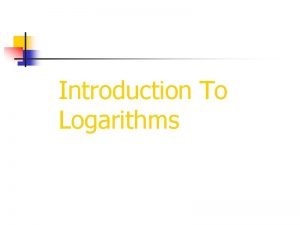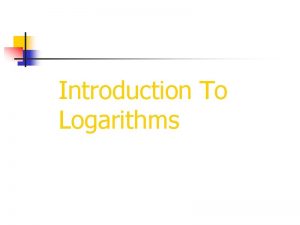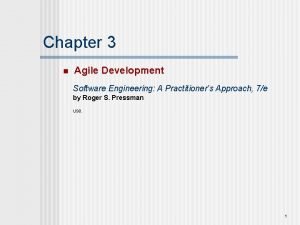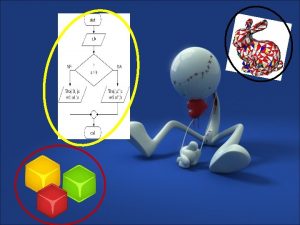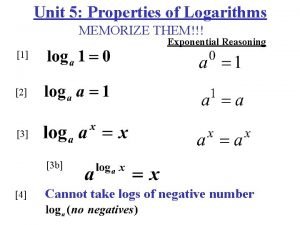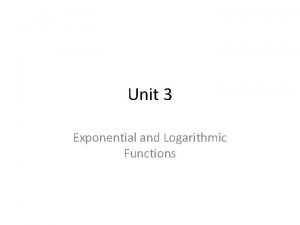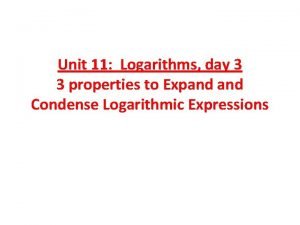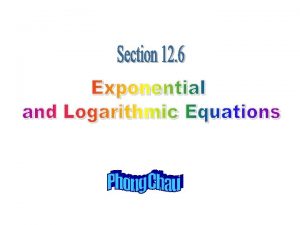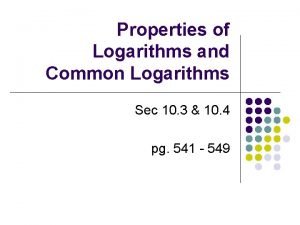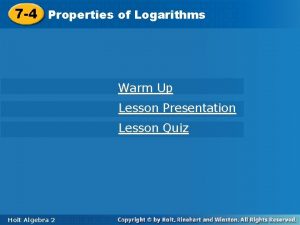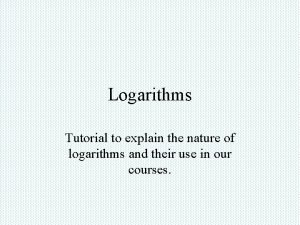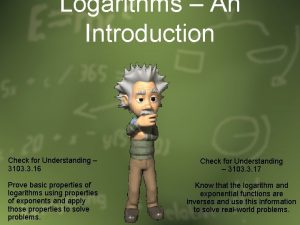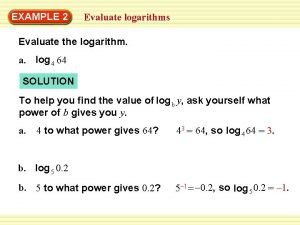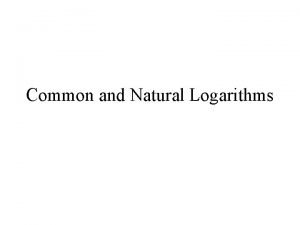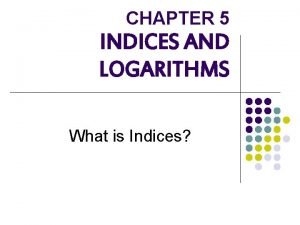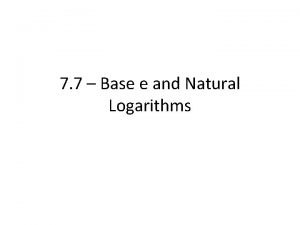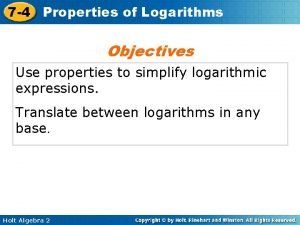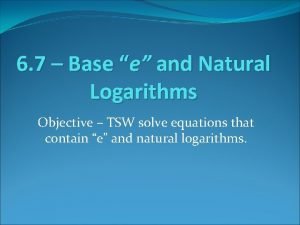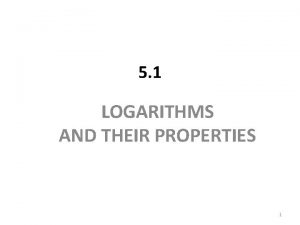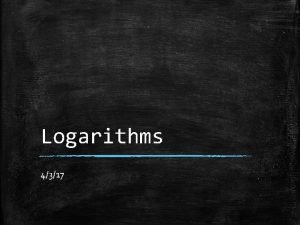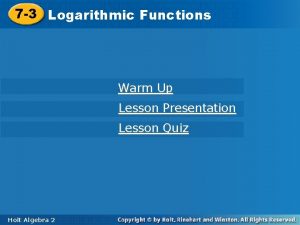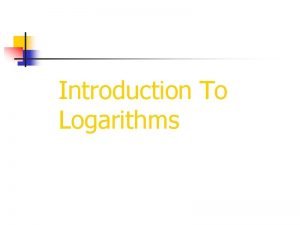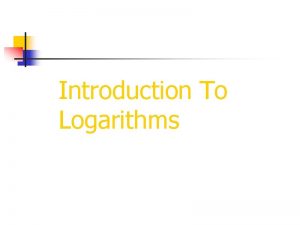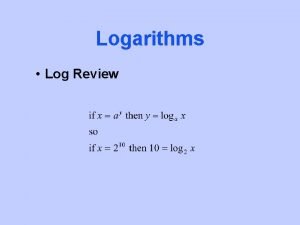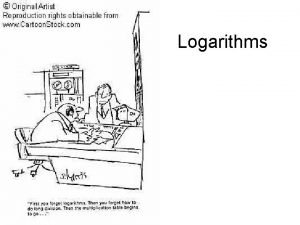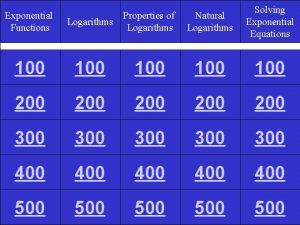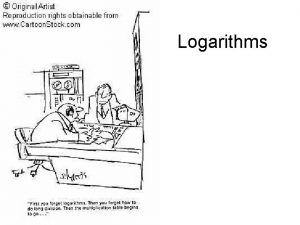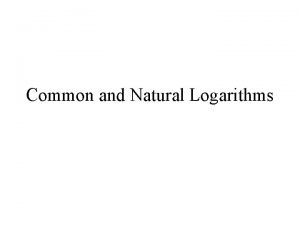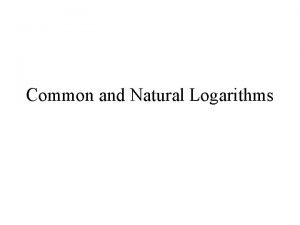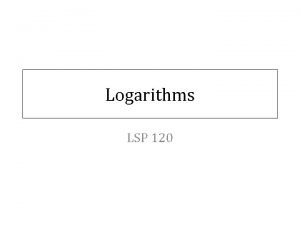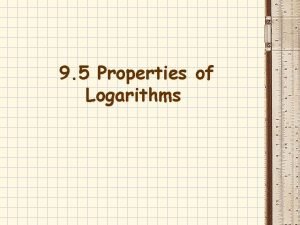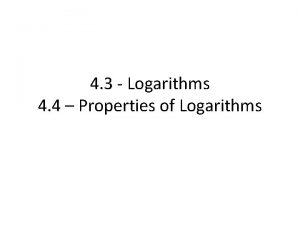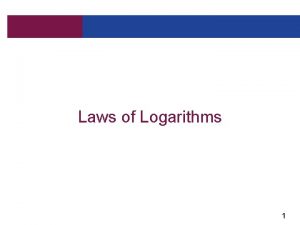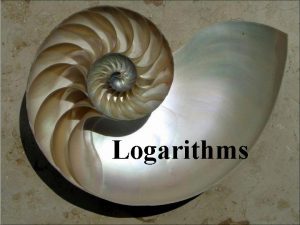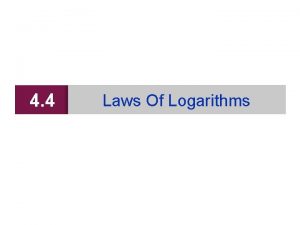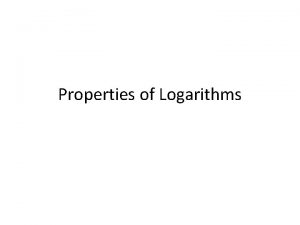Introduction To Logarithms Logarithms were originally developed to



















































- Slides: 51

Introduction To Logarithms

Logarithms were originally developed to simplify complex arithmetic calculations. They were designed to transform multiplicative processes into additive ones.

If at first this seems like no big deal, then try multiplying 2, 234, 459, 912 and 3, 456, 234, 459. Without a calculator ! Clearly, it is a lot easier to add these two numbers.

Today of course we have calculators and scientific notation to deal with such large numbers. So at first glance, it would seem that logarithms have become obsolete.

Indeed, they would be obsolete except for one very important property of logarithms. It is called the power property and we will learn about it in another lesson. For now we need only to observe that it is an extremely important part of solving exponential equations.

Our first job is to try to make some sense of logarithms.

Our first question then must be: What is a logarithm ?

Of course logarithms have a precise mathematical definition just like all terms in mathematics. So let’s start with that.

Definition of Logarithm Suppose a>0 and a≠ 1, there is a number ‘x’ such that: if and only if

Now a mathematician understands exactly what that means. But, many a student is left scratching their head.

The first, and perhaps the most important step, in understanding logarithms is to realize that they always relate back to exponential equations.

You must be able to convert an exponential equation into logarithmic form and vice versa. So let’s get a lot of practice with this !

1. log. Break. Ice = the 2. log. Burst. Bubble = Your 3. log. Drive. Nuts = Me 4. log. Dropping. Flies = Like 5. log. Throw. Thursday = back 6. log. You Only. Once = Live 7. log. Easy. Pie = as 8. log. Do Get It = You

Example 1: Write Solution: in exponential form. 23 = 8

Work it in Reverse Example 1: Solution: We read this as: ”the log base 2 of 8 is equal to 3”.

Example 2: Write Solution: in exponential form. 42 = 16

Work it in Reverse Example 2: Write 42 = 16 in logarithmic form. Solution: We read this as: ”the log base 4 of 16 is equal to 2”.

Example 3: Write Solution: in exponential form. 2 -3 =

Work it in Reverse Example 3: Solution:

Okay, so now it’s time for you to try some on your own.

Solution:

Solution:

Solution:

Let’s look at a logarithm with base e A base e logarithm of x is ln(x) = loge(x) = y This is referred to as the natural logarithm.

5. Write e 0 = 1 in logarithmic form. Solution:

6. Write e 1 = 2. 7183 in logarithmic form. Solution:

6. Write e 3 = 20. 09 in logarithmic form. Solution:

It is also very important to be able to start with a logarithmic expression and change this into exponential form. This is simply the reverse of what we just did.

Example 1: Solution:

Example 2: Solution:

Okay, now you try these next four. 4. Write ln 5 = 1. 6094379 in exp onential form.

Solution:

Solution:

Solution: 31/3=27

4. Write ln 5 = 1. 6094379 in exp onential form. Solution: e 1. 6094379 = 5

We now know that a logarithm is perhaps best understood as being closely related to an exponential equation. In fact, whenever we get stuck in the problems that follow we will return to this one simple insight. We might even state a simple rule.

When working with logarithms, if ever you get “stuck”, try rewriting the problem in exponential form. Conversely, when working with exponential expressions, if ever you get “stuck”, try rewriting the problem in logarithmic form.

Let’s see if this simple rule can help us solve some of the following problems.

Solution: Let’s rewrite the problem in exponential form. x = 36

Solution: Rewrite the problem in exponential form.

Example 3 Solution: Try setting this up like this: Now rewrite in exponential form.

These next two problems tend to be some of the trickiest to evaluate. Actually, they are merely identities and the use of our simple rule will show this.

Example 4 Solution: First, we write the problem with a variable. Now take it out of the logarithmic form and write it in exponential form.

Example 5 Solution: First, we write the problem with a variable. Now take it out of the exponential form and write it in logarithmic form.

Day 2 How do you solve logarithmic equations? Finally, we want to take a look at the Property of Equality for Logarithmic Functions. Suppose a > 0 and a ≠ 1 Then logax 1 = logax 2 if and only if x 1 = x 2 Basically, with logarithmic functions, if the bases match on both sides of the equal sign , then simply set the arguments equal.

Example 1 Solution: Since the bases are both ‘ 3’ we simply set the arguments equal.

Example 2 Solution: Since the bases are both ‘ 8’ we simply set the arguments equal. Factor continued on the next page

Example 2 continued Solution: It appears that we have 2 solutions here. If we take a closer look at the definition of a logarithm however, we will see that not only must we use positive bases, but also we see that the arguments must be positive as well. Therefore -2 is not a solution. Let’s take a closer look at this.

Our final concern then is to determine why logarithms like the one below are undefined. Can anyone give us an explanation ?

One easy explanation is to simply rewrite this logarithm in exponential form. We’ll then see why a negative value is not permitted. First, we write the problem with a variable. Now take it out of the logarithmic form and write it in exponential form. What power of 2 would gives us -8 ? Hence expressions of this type are undefined.

Let’s take a look at some additional problems. Open books to page 295/ #88 -98 even. Let’s make sure we do some natural log problems.
 Unix was originally developed in
Unix was originally developed in Why was the gps network originally developed
Why was the gps network originally developed When did the vikings live
When did the vikings live 2) greek dramas were originally performed ____.
2) greek dramas were originally performed ____. Introduction of logarithms
Introduction of logarithms Introduction to logarithms
Introduction to logarithms Was/were supposed to
Was/were supposed to Volleyball net hight
Volleyball net hight A whalebone that originally contained 200 grams
A whalebone that originally contained 200 grams Carol ann duffy originally
Carol ann duffy originally Originally duffy poem
Originally duffy poem Playdoh when was it invented
Playdoh when was it invented Nostalgia carol ann duffy genius
Nostalgia carol ann duffy genius A biologist originally marked 40 butterflies
A biologist originally marked 40 butterflies Primate city countries
Primate city countries Manmeet gill
Manmeet gill A piece of copper originally 305mm long
A piece of copper originally 305mm long Where do bananas originally come from
Where do bananas originally come from Even though beowulf was originally dgp
Even though beowulf was originally dgp The most widely used agile process, originally proposed by
The most widely used agile process, originally proposed by How was the coffee maker originally made
How was the coffee maker originally made Short story sniper
Short story sniper The spiral model was originally proposed by
The spiral model was originally proposed by Rubik's cube magic
Rubik's cube magic Originally carol ann duffy questions
Originally carol ann duffy questions Most students enjoy going to picnic
Most students enjoy going to picnic What organism was aspirin originally extracted from
What organism was aspirin originally extracted from Originally carol ann duffy questions
Originally carol ann duffy questions Unit 8 exponential and logarithmic functions
Unit 8 exponential and logarithmic functions Logarithm rules and examples
Logarithm rules and examples Logarithmic to exponential form
Logarithmic to exponential form How to condense logarithms
How to condense logarithms Log to exponential form
Log to exponential form Laws of logarithms
Laws of logarithms Logarithm power rule
Logarithm power rule Common logarithm
Common logarithm Te warm
Te warm Mathematics n2 modules
Mathematics n2 modules Logarithms tutorial
Logarithms tutorial Understanding logarithms
Understanding logarithms Evaluate natural log of 8
Evaluate natural log of 8 Exponential differentiation
Exponential differentiation Natural logs
Natural logs Logarithms
Logarithms How to undo exponents
How to undo exponents Exponential equation solver
Exponential equation solver 7-4 properties of logarithms
7-4 properties of logarithms Single natural logarithm
Single natural logarithm Log of a number
Log of a number Logs in chemistry
Logs in chemistry Logarithm desmos
Logarithm desmos Quiz 7-3 logarithmic and exponential equations
Quiz 7-3 logarithmic and exponential equations




